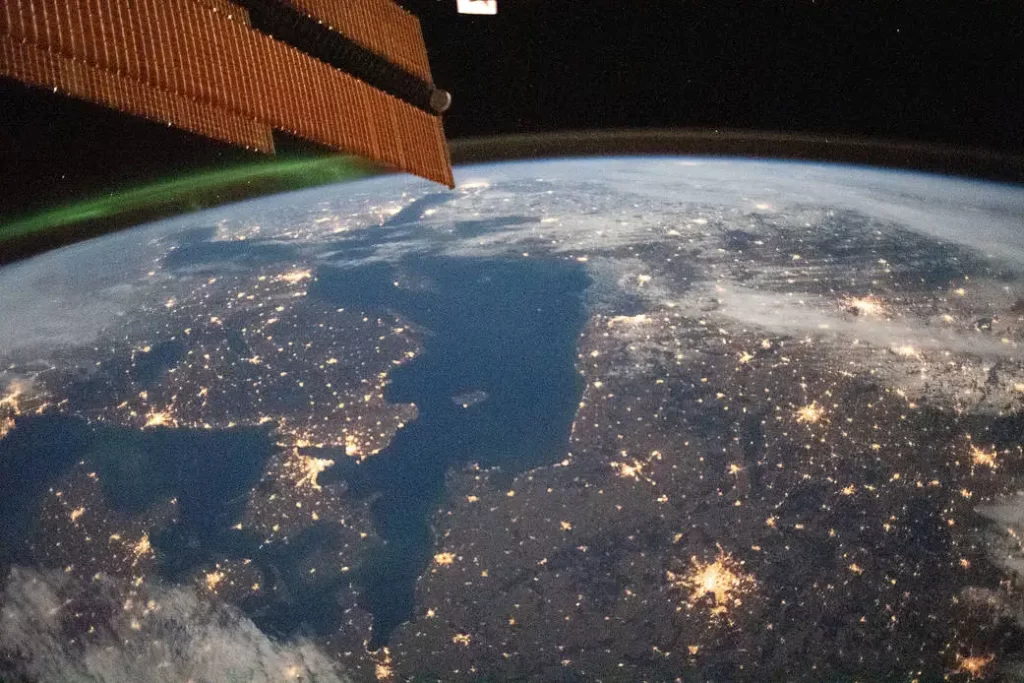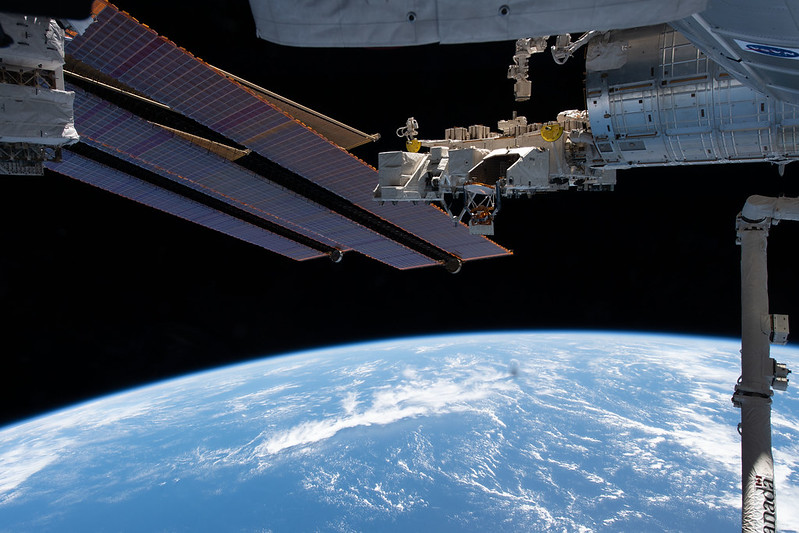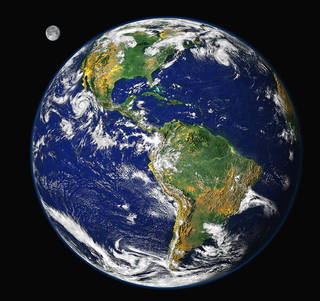Last updated on December 11th, 2025
70. The Earth and the Sun: The minimum distance between the earth and the Sun (perihelion) is 147.1 million kilometers and the maximum distance (aphelion) between the earth and the Sun is 152.1 million kilometers.
71. There is a possibility that some asteroid/comet may hit earth and cause devastation to life. A similar event 65 million years ago happened and wiped out the dinosaurs from the planet.
72. Since record keeping for temperature began in 1850, 2023 was recorded as the hottest year ever. 2023 had a global average temperature of 14.98°C, 0.17°C higher than the previous highest annual value in 2016.
73. Scientists have recently estimated that an ocean of water exists at a distance of 1,000 km under the surface of the Earth. And this water is important for volcanic activity, which in turn is responsible for generating soil.
Atmosphere of the Earth
74. The Earth’s atmosphere is essential for life: it contains oxygen for breathing, acts as a protecting barrier against ultraviolet radiation from the Sun, generates enough pressure to prevent liquid water from completely evaporating, and retains enough of the Sun’s energy to maintain warm temperatures.
75. The Earth’s atmosphere is composed of 78% nitrogen, 21% oxygen, and 1% other gases.
76. The troposphere is the layer of the Earth’s atmosphere that is closest to the surface. It is where most of the weather phenomena, for example clouds, occur.
77. The temperature and availability of oxygen decrease while moving up the troposphere, the layer of the atmosphere closest to the planet’s surface. That is why mountaineers require special gear, including canisters of oxygen, when climbing high mountains like Mount Everest.
78. The stratosphere is the second layer of the Earth’s atmosphere. Here is where the ozone layer is located, which prevents harmful UV rays from the Sun reaching the planet’s surface.
79. The mesosphere is the third layer of the Earth’s atmosphere, where meteors disintegrate when their trajectory leads to Earth. The friction between the meteor and the gases in the atmosphere generate high temperatures that end up vaporising the rock. As a consequence, there is a relatively high concentration of iron and other metals compared to other layers.

80. The ionosphere is rich in ionised atoms and molecules, and is where the phenomena of the aurorae occur, and where radio waves reflect to allow communication and navigation.
81. When energetic particles from the Solar winds interact with the Earth’s magnetosphere in the poles, they are precipitated into the ionosphere (layer of the atmosphere rich in ionised atoms and molecules) as a wave. The collision between them and the gases in the atmosphere generate a display of lights called “aurora”.The one on the North Pole is called “aurora borealis” or “northern lights”, while the one on the South Pole is called “aurora australis” or “southern lights”.
82. The colour of the aurorae on the poles of the Earth is due to the collision of energetic magnetic particles from the Solar winds with the gases in the atmosphere. Oxygen gives off green and red light, while nitrogen glows blue and purple.

83. The thermosphere is the thickest layer of the Earth’s atmosphere. It is rich in light gases like oxygen, helium, and hydrogen. The Hubble Space Telescope and the International Space Station (ISS) orbit Earth here.
84. The exosphere is the outermost layer of the Earth’s atmosphere. Hydrogen is the predominant element here. Many weather satellites orbit the Earth in the exosphere.
85. The Earth’s magnetosphere (magnetic field) protects the planet by preventing the erosion of the atmosphere by Solar winds, repelling particle radiation from the Sun, and keeping harmful cosmic rays at a safe distance.
86. The Earth’s magnetosphere (magnetic field) is generated by the motion of molten iron, sulphur, and hydrogen compounds in the Earth’s core. It is stronger on the Poles than on the Equator.

87. The Earth’s magnetosphere (magnetic field) has its weakest point in South America, over the Atlantic Ocean, and is called “South Atlantic Anomaly”. Although the Solar winds do not affect the planet’s surface, they penetrate the atmosphere enough to fry spacecraft electronics.
88. The oceans cover 70% of the surface of the Earth, and contain 97% of all the water of the planet.
89. Only 1.2% of all the water in the planet Earth is potable, i.e. suitable for drinking and cooking.
90. More than 50% of the oxygen on Earth is generated by the phytoplankton in the oceans. Pollution of the oceans kills these microorganisms, reducing oxygen production.
91. Forests and tropical forests produce 40% of the oxygen on Earth, house around 80% of the whole biodiversity on land, and play a crucial role in the carbon cycle. Conservation of forests is of the utmost importance.
92. When the Earth was formed 4.5 billion years ago, the day was less than 10 hours long. The speed at which the Earth rotates on its axis is getting slower over time, in part due to the effect of the tides caused by the Moon.
Tides
Tides are massive waves that move across the oceans. They are caused by the gravitational force that the Moon exerts on the Earth. As the Earth rotates, different parts of the planet are exposed to the Moon, and this rotation causes the tide cycles around the planet.
The tides and the influence they have on the gravitational pull the Earth exerts over the Moon are making the Moon move farther away from Earth.
The Moon’s, and in less degree the Sun’s, gravitational forces affects the water on the Earth causing the tides. To a lesser extent, they also affect the land, moving it up and down up to 55 centimetres (22 inches) a day.
It is thought that 4.5 billion years ago the Earth was hit by a small planet of the size of Mars, and that the debris resulting from the collision eventually accreted to form the Moon.
The temperature of the core of the Earth is almost the same as the temperature of the surface of the Sun.
Life forms found in the depth of the oceans have adapted to the extreme conditions, and grow very slowly compared to those found on the surface. They survive the extreme pressure, high/low temperatures, lack of light, and limited nutrient availability.
Wobbling of the Earth
As Earth rotates, it wobbles slightly on its axis and drifts slowly around the poles. This is called “axial precession”, and although it does not affect our daily lives, it is taken into account by global position systems (GPS).
The wobbling of the Earth on its axis while it rotates is called “axial precession” and is responsible for making the seasons more extreme in one hemisphere than the other. Currently, winter is more extreme in the Northern Hemisphere, while summer is more extreme in the Southern Hemisphere.
It is thought that the periods of glaciation on Earth are cyclical, and are influenced by three main factors: the level of eccentricity of Earth’s orbit around the Sun, changes in the angle between the Equator and the orbit, and the wobbling of the axis while Earth rotates (axial precession).
The frequency of the periods of glaciations on Earth can be modelled and are called “Milankovitch cycles”. This model can calculate when the next ice age will happen, but it is thought that the high amount of CO2 in the atmosphere will delay it.
Asteroids, craters and meteors
A very large asteroid impacted the Earth 65 million years ago, which may have lead to the extinction of animals on land and water, including the dinosaurs. Evidence of this hit is the Chicxulub Crater on the Yucatan Peninsula in Mexico, which is 300 kilometres (180 miles) wide.
One of the most intact impact craters on Earth is the Barringer Meteorite Crater in Arizona, USA, and provides invaluable information to geologists about impact processes. It is approximately 1 kilometer (0.6 miles) wide, and was caused by a meteorite approximately 50 metres (164 feet) in diameter.
The latest observation of a meteor reaching Earth occurred in February 2023. The meteor entered the atmosphere and disintegrated over the coast of Normandy, France, along the English Channel.
Quick facts about Earth
| Orbit size around the Sun | 149,598,262 km |
|---|---|
| Mean orbit velocity | 107,218 km/h |
| Equatorial Radius | 6,371.00 km |
| Equatorial Circumference | 40,030.2 km |
| Volume | 1,083,206,916,846 cubic kilometer |
| Mass | 5,972,190,000,000,000,000,000,000 kg |
| Density | 5.513 gram per cubic centimeter |
| Surface area | 510,064,472 kilometer square |
| Surface Gravity | 9.80665 meter per second square |
| Surface Temperature | -88/58 (min/max) °C |
